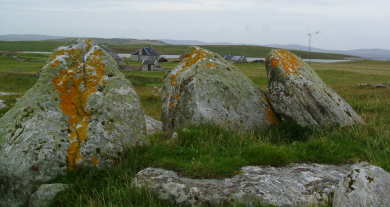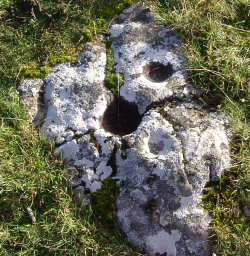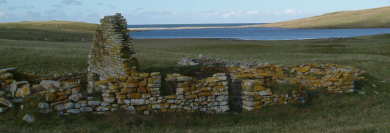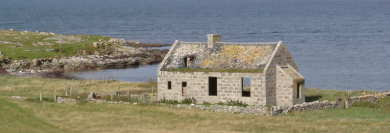| |
Sound of Harris - Outer Hebrides - Scotland |
|
BORERAY
- History |
 |
There is evidence of longstanding human settlement on Boreray. Artefacts
and burial remains dating back at least 5,000 years have been discovered
amongst the shifting sands of the dunes. A number of ancient standing
stones are to be found around the island. The group pictured left
are thought to have formed one side of a Neolithic burial chamber.
|
Cailleacha Dubha |
Towards the south-east of the island lies the burial
ground known as Cladh Manach; it's said to contain
the remains of St Donnan - a Pictish monk who followed the
early Christian teachings of St Ninian - and 52 companions,
all assassinated on the Isle of Eigg in 617 AD. There is a
cup-marked stone
(right) near the grave mounds on this
site (below).
|
 |
|
| |
 |
| |
| In around 1460, the island was acquired by Clan MacLean of
Ardgour following a costly game of draughts for Lord MacDonald of Sleat.
The MacLeans were to remain until the early nineteenth century. Evidence
of the considerable works to improve Boreray's infrastructure - roads,
walls, pier and a drainage system for Loch Mor - is still discernible.
Few people would actually have lived on Boreray during the MacLeans' stewardship,
but there was plenty of work for day-labourers from North Uist. |
| |
 |
| |
| The thirteenth MacLean of Boreray finally left the island
in around 1810. and it was divided into twenty crofts. The population
grew quickly; the census of 1841 recorded 181 inhabitants. Many of the
numerous ruined houses on the island date back to this particular era
(The taller house above was one of the last, built c1900). |
| |
|
|
Despite the efforts of the Free Church of Scotland, who provided
a fine church (pictured lower left) and schoolhouse in 1880,
over-cultivation and the collapse of the kelp trade contributed to
a gradual population decline until, by 1925, the last islanders were
evacuated. One family - descended from the MacLeans - subsequently
returned to the island, and the single, existing croft was created.
After Colin MacLean's death, Boreray was again abandoned in the 1960’s.
In 1999 the present crofter, Jerry Cox, started rebuilding work and
remains the island’s sole inhabitant.
|
|
| The remainder of Boreray (outwith the croft) continues to
be used as common grazings by Borve township, Berneray. |
|
|





